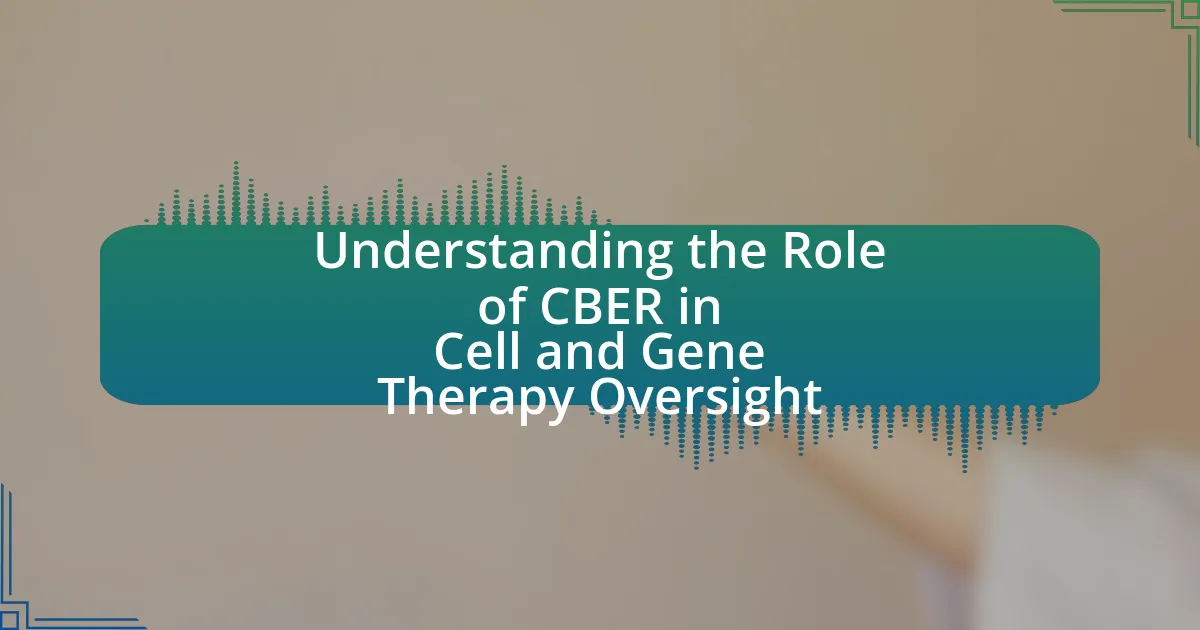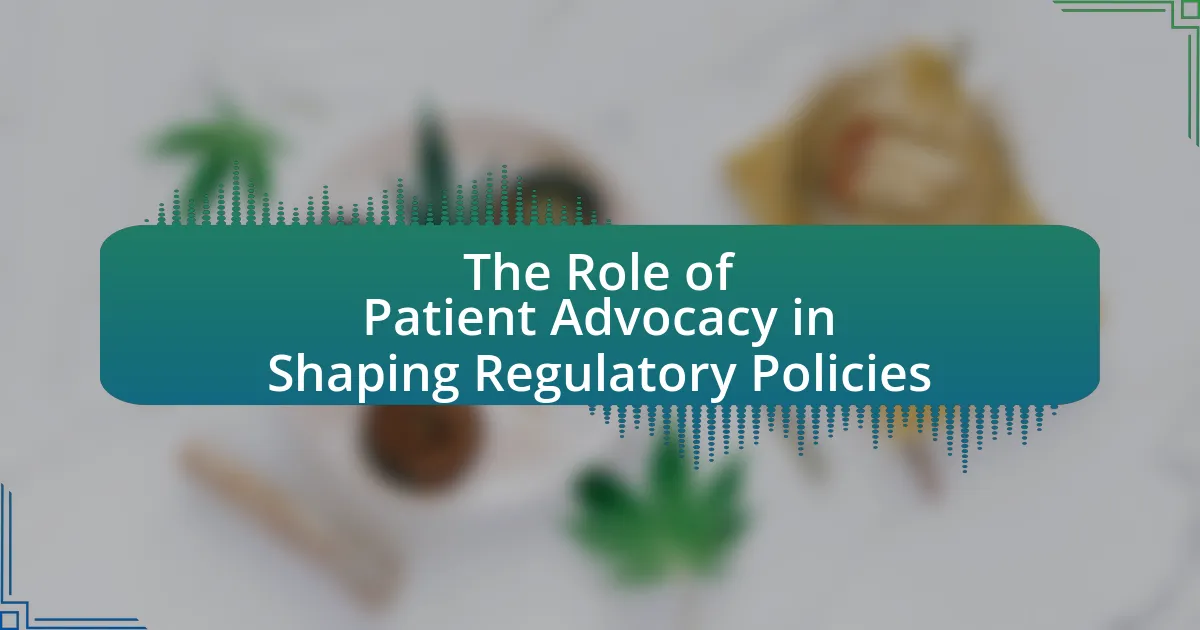The article focuses on best practices for regulatory submissions in cell and gene therapy, emphasizing the importance of thorough preclinical data generation, robust clinical trial design, and adherence to regulatory guidelines. It outlines the critical role of regulatory agencies, such as the FDA and EMA, in ensuring the safety, efficacy, and quality of innovative therapies. Key components of successful submissions include comprehensive documentation, effective communication with regulatory authorities, and strategies for addressing feedback. The article also discusses the challenges companies face in navigating the regulatory landscape and highlights the significance of different regulatory pathways and designations that can impact submission timelines and approval processes.

What are the Best Practices for Regulatory Submissions in Cell and Gene Therapy?
The best practices for regulatory submissions in cell and gene therapy include thorough preclinical data generation, clear and comprehensive clinical trial design, and adherence to regulatory guidelines. Preclinical data should demonstrate safety and efficacy through well-structured studies, as evidenced by the FDA’s guidance on preclinical assessment for gene therapy products. Clinical trial designs must be robust, with endpoints that are clinically meaningful and aligned with regulatory expectations, as highlighted in the ICH E6 guidelines for Good Clinical Practice. Additionally, maintaining open communication with regulatory agencies throughout the submission process can facilitate smoother reviews and address potential issues early, as recommended by the FDA’s guidance on the Investigational New Drug (IND) application process.
Why are regulatory submissions critical in cell and gene therapy?
Regulatory submissions are critical in cell and gene therapy because they ensure the safety, efficacy, and quality of these innovative treatments. Regulatory agencies, such as the FDA and EMA, require comprehensive data on the product’s development, manufacturing processes, and clinical trial results to assess potential risks and benefits. For instance, the FDA’s approval of CAR-T cell therapies, like Kymriah and Yescarta, was contingent upon rigorous regulatory submissions that demonstrated their effectiveness in treating certain types of cancer. These submissions facilitate transparency, promote public trust, and guide manufacturers in adhering to established standards, ultimately leading to safer and more effective therapies for patients.
What role do regulatory agencies play in the approval process?
Regulatory agencies are responsible for evaluating and approving new therapies, including cell and gene therapies, to ensure their safety, efficacy, and quality. These agencies, such as the U.S. Food and Drug Administration (FDA) and the European Medicines Agency (EMA), establish guidelines and requirements that developers must follow during the submission process. For instance, the FDA requires comprehensive data from preclinical and clinical trials to assess the therapeutic benefits and risks before granting approval. This structured review process is critical in protecting public health and ensuring that only safe and effective therapies reach the market.
How do regulatory submissions impact patient safety and efficacy?
Regulatory submissions significantly impact patient safety and efficacy by ensuring that therapies undergo rigorous evaluation before approval. These submissions require comprehensive data on clinical trials, manufacturing processes, and potential risks, which helps identify any safety concerns and assess the therapeutic benefits. For instance, the U.S. Food and Drug Administration (FDA) mandates that all new therapies demonstrate a favorable risk-benefit profile through well-designed clinical studies, which directly influences patient outcomes. This process is crucial in preventing unsafe products from reaching the market, thereby protecting patients and enhancing the overall efficacy of approved treatments.
What are the key components of a successful regulatory submission?
The key components of a successful regulatory submission include comprehensive data packages, clear and concise documentation, adherence to regulatory guidelines, and robust risk management strategies. Comprehensive data packages must encompass preclinical and clinical trial data, manufacturing processes, and quality control measures, ensuring that all relevant information is presented. Clear and concise documentation facilitates the review process by providing straightforward explanations of the data and methodologies used. Adherence to regulatory guidelines, such as those set forth by the FDA or EMA, is critical for compliance and acceptance of the submission. Finally, robust risk management strategies demonstrate an understanding of potential risks associated with the therapy and outline mitigation plans, which is essential for regulatory approval.
What documentation is required for regulatory submissions?
Regulatory submissions require comprehensive documentation, including a clinical trial application, investigator’s brochure, informed consent forms, and a detailed study protocol. These documents ensure that the regulatory authorities have sufficient information to assess the safety and efficacy of the cell and gene therapy products. For instance, the clinical trial application must include data on preclinical studies, manufacturing processes, and proposed clinical trial designs, which are critical for regulatory review.
How should data be presented in regulatory submissions?
Data in regulatory submissions should be presented clearly, accurately, and in a structured format that adheres to regulatory guidelines. This includes using standardized templates, ensuring data integrity, and providing comprehensive documentation that supports the findings. For instance, the International Council for Harmonisation (ICH) guidelines emphasize the importance of clarity and consistency in data presentation, which facilitates the review process by regulatory authorities. Additionally, presenting data in tables, figures, and appendices enhances readability and allows for easier interpretation of complex information.
What challenges do companies face in regulatory submissions for cell and gene therapy?
Companies face significant challenges in regulatory submissions for cell and gene therapy, primarily due to the complexity of the therapies and the evolving regulatory landscape. The intricacies of demonstrating safety and efficacy for novel therapies, which often involve genetic modifications, require extensive preclinical and clinical data. Additionally, the lack of standardized guidelines from regulatory bodies like the FDA and EMA can lead to uncertainty in submission processes. For instance, the FDA’s guidance on gene therapy has been evolving, which can complicate compliance for companies. Furthermore, the high costs associated with conducting the necessary trials and the lengthy timelines for approval can strain resources, particularly for smaller companies. These factors collectively contribute to the difficulties faced in navigating the regulatory environment for cell and gene therapies.
What are common pitfalls in the submission process?
Common pitfalls in the submission process include inadequate documentation, failure to meet regulatory requirements, and poor communication with regulatory agencies. Inadequate documentation can lead to delays or rejections, as submissions must include comprehensive data on safety, efficacy, and manufacturing processes. Failure to meet regulatory requirements often results from not understanding the specific guidelines set by agencies like the FDA or EMA, which can vary significantly for cell and gene therapies. Poor communication with regulatory agencies can hinder the submission process, as it may lead to misunderstandings or misinterpretations of the data required. These pitfalls are well-documented in industry reports, highlighting the importance of thorough preparation and adherence to guidelines to ensure successful submissions.
How can companies address regulatory feedback effectively?
Companies can address regulatory feedback effectively by implementing a structured response process that includes thorough analysis, timely communication, and actionable changes. This involves first reviewing the feedback in detail to understand the specific concerns raised by regulatory bodies. Following this, companies should engage in open dialogue with regulators to clarify any ambiguities and demonstrate a commitment to compliance.
Additionally, companies must develop a plan to address the feedback, which may include revising submission documents, conducting additional studies, or enhancing quality control measures. For instance, a study published in the “Journal of Gene Medicine” highlights that companies that proactively engage with regulators and adapt their submissions based on feedback tend to achieve faster approval times. This structured approach not only ensures compliance but also fosters a collaborative relationship with regulatory authorities, ultimately leading to more successful outcomes in the regulatory process.
How can companies ensure compliance with regulatory requirements?
Companies can ensure compliance with regulatory requirements by implementing a robust compliance management system that includes regular training, thorough documentation, and continuous monitoring of regulatory changes. This system should involve establishing clear policies and procedures that align with the specific regulations governing cell and gene therapy, such as those set forth by the FDA and EMA. Regular audits and assessments can help identify gaps in compliance, while engaging with regulatory bodies through consultations can provide clarity on expectations. Additionally, leveraging technology for data management and reporting can streamline compliance processes, ensuring that all submissions meet the necessary standards.
What strategies can enhance the quality of regulatory submissions?
To enhance the quality of regulatory submissions, implementing a structured approach that includes thorough documentation, early engagement with regulatory authorities, and adherence to guidelines is essential. Thorough documentation ensures that all necessary data and information are accurately presented, which is critical for regulatory review. Early engagement with regulatory authorities allows for clarification of expectations and requirements, reducing the likelihood of misunderstandings. Adhering to established guidelines, such as those from the FDA or EMA, ensures compliance with regulatory standards, which is vital for successful submissions. These strategies collectively improve the clarity, completeness, and compliance of submissions, ultimately facilitating a smoother regulatory review process.

How do different regulatory pathways affect submissions in cell and gene therapy?
Different regulatory pathways significantly influence submissions in cell and gene therapy by determining the requirements for data, timelines, and approval processes. For instance, the FDA offers pathways such as the Biologics License Application (BLA) and the Investigational New Drug (IND) application, each with distinct data requirements and review timelines. The BLA requires comprehensive clinical data demonstrating safety and efficacy, while the IND focuses on initial safety data to begin clinical trials. Additionally, the Regenerative Medicine Advanced Therapy (RMAT) designation can expedite the review process for therapies that address unmet medical needs, allowing for faster access to the market. These regulatory distinctions necessitate tailored submission strategies to meet specific requirements, impacting the overall development timeline and resource allocation for companies involved in cell and gene therapy.
What are the various regulatory pathways available for cell and gene therapies?
The various regulatory pathways available for cell and gene therapies include the Biologics License Application (BLA), the Investigational New Drug (IND) application, and the Regenerative Medicine Advanced Therapy (RMAT) designation. The BLA is used for the approval of biologics, including cell and gene therapies, requiring comprehensive data on safety and efficacy. The IND application allows for clinical trials to begin, ensuring that therapies are safe for human testing. The RMAT designation expedites the development and review of regenerative medicine therapies, providing benefits like increased interaction with the FDA and potential priority review. These pathways are established by regulatory agencies such as the FDA to ensure that innovative therapies meet safety and efficacy standards while facilitating timely access for patients.
How does the Fast Track designation influence submission timelines?
The Fast Track designation significantly accelerates submission timelines by facilitating more frequent interactions between the sponsor and the regulatory agency. This designation allows for rolling submissions, meaning that portions of the application can be submitted and reviewed as they are completed, rather than waiting for the entire application to be finalized. According to the FDA, this process can lead to quicker feedback and potentially shorter review times, ultimately expediting the path to market for therapies that address unmet medical needs.
What is the significance of Breakthrough Therapy designation?
The significance of Breakthrough Therapy designation lies in its ability to expedite the development and review process for drugs that treat serious conditions and fill an unmet medical need. This designation, granted by the FDA, allows for more intensive guidance from the agency and the potential for rolling review, which can significantly shorten the time to market for innovative therapies. For instance, drugs that receive this designation may benefit from increased communication with the FDA, leading to a more efficient path through clinical trials and regulatory approval.
How do international regulations impact submissions for cell and gene therapy?
International regulations significantly impact submissions for cell and gene therapy by establishing standardized requirements that must be met for approval. These regulations, such as those set forth by the FDA in the United States and the EMA in Europe, dictate the necessary preclinical and clinical data, manufacturing practices, and safety assessments that must be included in submissions. For instance, the FDA requires a comprehensive Investigational New Drug (IND) application that includes detailed information on the product’s chemistry, manufacturing, and controls, as well as clinical trial protocols. Compliance with these regulations ensures that therapies are safe and effective, ultimately influencing the speed and success of the approval process.
What are the differences between FDA and EMA submission processes?
The FDA and EMA submission processes differ primarily in their regulatory frameworks and timelines. The FDA operates under a more streamlined process, allowing for faster approvals, often within 10 months for New Drug Applications (NDAs) and 6 months for Priority Review, while the EMA typically requires a 210-day review period for Marketing Authorization Applications (MAAs). Additionally, the FDA emphasizes a more flexible approach to clinical trial design, including adaptive trials, whereas the EMA has stricter guidelines on trial protocols and data requirements. These differences reflect the FDA’s focus on expediting access to innovative therapies and the EMA’s commitment to thorough evaluation and safety standards.
How can companies navigate global regulatory requirements?
Companies can navigate global regulatory requirements by establishing a comprehensive compliance strategy that includes understanding local regulations, engaging with regulatory authorities, and utilizing expert guidance. This approach ensures that companies remain informed about the varying requirements across different jurisdictions, such as the FDA in the United States and the EMA in Europe, which have distinct processes for cell and gene therapy submissions. Engaging with regulatory authorities early in the development process can facilitate smoother interactions and clarify expectations, as evidenced by the FDA’s guidance documents that outline specific requirements for gene therapy products. Additionally, leveraging the expertise of regulatory consultants can provide insights into best practices and help streamline the submission process, ultimately enhancing the likelihood of successful approvals.

What are the best practices for preparing a regulatory submission in cell and gene therapy?
The best practices for preparing a regulatory submission in cell and gene therapy include thorough preclinical data collection, adherence to regulatory guidelines, and comprehensive documentation of manufacturing processes. Preclinical data should demonstrate safety and efficacy through well-designed studies, as regulatory agencies require robust evidence before clinical trials can commence. Adhering to guidelines from organizations such as the FDA and EMA ensures compliance with safety and quality standards, which is critical for approval. Additionally, detailed documentation of the manufacturing process, including quality control measures and product characterization, is essential to demonstrate consistency and reliability of the therapy. These practices are supported by regulatory frameworks that emphasize the importance of data integrity and transparency in submissions.
How can effective project management improve submission outcomes?
Effective project management can significantly improve submission outcomes by ensuring that all regulatory requirements are met systematically and efficiently. By implementing structured planning, resource allocation, and timeline management, project managers can minimize errors and delays in the submission process. For instance, a study published in the Journal of Regulatory Affairs highlighted that organizations employing rigorous project management methodologies experienced a 30% reduction in submission-related rejections compared to those without such practices. This demonstrates that effective project management not only streamlines the submission process but also enhances the quality of the submissions, leading to higher approval rates in the highly regulated field of cell and gene therapy.
What tools and resources are available for managing regulatory submissions?
Regulatory submissions can be effectively managed using specialized software tools and resources designed for compliance and documentation. Tools such as Veeva Vault, MasterControl, and Oracle’s Siebel CTMS provide comprehensive solutions for document management, tracking submissions, and ensuring adherence to regulatory standards. These platforms facilitate collaboration among stakeholders, streamline workflows, and maintain audit trails, which are essential for compliance with regulatory agencies like the FDA and EMA. Additionally, resources such as the FDA’s eSubmitter and the European Medicines Agency’s (EMA) submission guidelines offer critical frameworks and templates that guide the submission process, ensuring that all necessary information is accurately presented.
How can cross-functional teams contribute to successful submissions?
Cross-functional teams contribute to successful submissions by integrating diverse expertise, which enhances the quality and comprehensiveness of regulatory documents. These teams typically include members from various departments such as clinical, regulatory affairs, quality assurance, and manufacturing, allowing for a holistic approach to submission preparation. For instance, the collaboration between clinical and regulatory experts ensures that clinical data is accurately represented and meets regulatory standards, thereby reducing the likelihood of submission rejections. Additionally, cross-functional teams facilitate effective communication and problem-solving, which streamlines the submission process and addresses potential issues proactively. This collaborative approach has been shown to improve submission timelines and increase the chances of regulatory approval, as evidenced by case studies in the pharmaceutical industry that highlight the success rates of submissions prepared by interdisciplinary teams compared to those prepared by isolated departments.
What role does communication play in the regulatory submission process?
Communication is essential in the regulatory submission process as it ensures clarity, transparency, and alignment between stakeholders, including regulatory agencies, sponsors, and clinical investigators. Effective communication facilitates the exchange of critical information, such as study design, data interpretation, and compliance with regulatory requirements, which are vital for successful submissions. For instance, the U.S. Food and Drug Administration (FDA) emphasizes the importance of pre-submission meetings to clarify expectations and address potential issues early in the process, thereby reducing the likelihood of delays or rejections. This structured dialogue helps to streamline the submission process and enhances the quality of the information provided, ultimately leading to more efficient regulatory reviews.
How can companies maintain transparency with regulatory agencies?
Companies can maintain transparency with regulatory agencies by implementing robust communication strategies and adhering to regulatory guidelines. Regularly submitting comprehensive and accurate data, including clinical trial results and safety information, fosters trust and ensures compliance. For instance, the FDA emphasizes the importance of timely reporting and clear documentation in its guidance for cell and gene therapy submissions. By proactively engaging with regulatory bodies through meetings and consultations, companies can clarify expectations and address potential concerns, thereby enhancing transparency and collaboration.
What are best practices for engaging with regulatory authorities?
Best practices for engaging with regulatory authorities include establishing clear communication channels, providing comprehensive and accurate documentation, and maintaining transparency throughout the process. Clear communication ensures that both parties understand expectations and requirements, which is crucial for successful interactions. Comprehensive documentation, including detailed data and analysis, supports the regulatory review process and demonstrates compliance with relevant guidelines. Transparency fosters trust and facilitates a collaborative relationship, allowing for timely feedback and resolution of potential issues. These practices are essential in the context of regulatory submissions in cell and gene therapy, where complex scientific data and regulatory standards must be effectively navigated.
What practical tips can enhance the success of regulatory submissions?
To enhance the success of regulatory submissions, it is crucial to ensure thorough documentation and adherence to regulatory guidelines. This involves preparing a comprehensive submission package that includes all required data, such as preclinical and clinical study results, manufacturing processes, and quality control measures. Following the International Council for Harmonisation (ICH) guidelines can significantly improve the clarity and completeness of submissions, as these guidelines are recognized by regulatory authorities globally. Additionally, engaging with regulatory agencies early in the development process through meetings or consultations can provide valuable feedback and help address potential issues before formal submission. This proactive approach has been shown to reduce review times and increase the likelihood of approval, as evidenced by the FDA’s Fast Track and Breakthrough Therapy designations, which facilitate expedited development and review processes for promising therapies.




